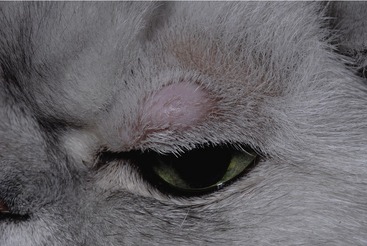mast cell tumor cat eyelid
Other names for MCT are mast cell sarcoma histiocytic mastocytoma and mastocytosis. Surgical excision of periocular CMCTs in cats is an effective treatment option with rare local recurrence and metastases even.
Multiple Eyelid Apocrine Hidrocystoma In A Domestic Short Haired Cat
Mast cell tumors occur more frequently on the eyelid than the conjunctiva.

. Does anyone have experience with excis. 89 thus they require a more urgent diagnostic and treatment plan. There were 12 squamous cell carcinomas SCCs 11 mast cell tumors MCTs 6 hemangiosarcomas HSAs 4 adenocarcinomas ACAs 3 peripheral nerve sheath tumors PNSTs 3 lymphomas 3 apocrine hidrocystomas AHCs and 2 hemangiomas.
Eyelid Tumors in Dogs. Cats were included if CMCTs were. This disease has a cutaneous form skin and a systemic form internal organs.
Animals studied Thirtythree cats with periocular CMCTs. Medical therapy is available for both tumor types and may induce regression of the tumor. The most common eyelid tumors of cats are squamous cell carcinomas 28 to 65 mastocytomas 3 to 26 hemangiosarcomas 2 to 14 lymphomas 7 to 11 adenocarcinomas 4 to 9 peripheral nerve sheath tumors.
Up to 20 of dogs will get a malignant Mast Cell Tumor MCT in their lifetime making it the most common tumor we encounter in dogs. For instance most eyelid masses in dogs are benign focally invasive tumors such as meibomian gland adenomas melanocytomas and papillomas. Squamous cell carcinomas These malignant tumors may involve the eyelids conjunctiva and third eyelid ie the wedge-shaped tissue at the inner corner of the eye and can vary in appearance from a thick non-healing ulcer to a rough pink irregularly shaped mass.
In our experience they are generally morphologically low to intermediate grade and clinically benign. In contrast to dogs eyelid tumors affecting cats are much more likely to be malignant. Lymphosarcoma and mast cell tumors mastocytomas are the next most common tumors that affect the feline eyelid.
Other forms of malignant tumors that occur in the eyelids of cats include basal cell carcinoma fibrosarcoma neurofibrosarcoma and melanoma. Significantly more males than females had eyelid tumors. 717 The last comprehensive study of the prevalence of feline eyelid tumors published in 1993 from the Veterinary Medical Data Program VMDP and the Purdue.
26 Squamous cell carcinoma is the most common eyelid neoplasm reported in cats. Cats on the other hand are more likely to develop aggressive or malignant tumors such as squamous cell carcinomas and mast. Most mast cell tumors arise in the skin but technically they can arise anywhere that mast cells are found.
Evaluation of surgical excision 33 cases Surgical excision of periocular CMCTs in cats is an effective treatment option with rare local recurrence and metastases even following incomplete surgical excision. Basal cell tumor. Periocular cutaneous mast cell tumors in cats.
34 SCC predominates particularly in cats with little to no pigmentation. EYELID MASSES IN CATS. There is currently no agreement on an appropriate grading system for canine conjunctival mast cell tumors.
The average age at diagnosis was 104 years. Tumors and tumor-like lesions of the eyelids are less common in cats than in dogs but more likely to be malignant. Mast Cell Tumors in Dogs and Cats.
Cats are more likely than dogs to have malignant or aggressive eyelid tumors such as. We have an appointment with oncology for staging next Monday 1030 and opthamology could do surgery the following day. Early preneoplastic lesions are typically erythematous scaly slightly raised lesions along the eyelid margins that.
Eosinophilic conjunctivitis was verified via cytology from a conjunctival scraping which revealed 50 eosinophils and 50 neutrophils. Procedures Medical records of cats diagnosed with periocular CMCTs were reviewed. Prognosis and treatment plans will depend on the tumor type species and age of the patient.
Conjunctival Mast Cell Tumor Smooth firm subconjunctival Well-circumscribed. Up to 91 of eyelid tumors in cats are malignant. 35 UV light damage from sunlight is believed to be a predisposing factor in the development of this tumor type.
Tumors and tumor-like lesions of the eyelids are less common in cats than in dogs but more likely to bemalignant26 Squamous cell carcinomais the most common eyelid neoplasm reported in cats717 The last comprehensive study of the prevalence of feline eyelid tumors published in 1993 from the Veterinary Medical Data Program VMDP and the Purdue. Mast cell tumors are notoriously invasive and difficult to treat. Meibomian Gland Tumors in Dogs.
Objective To describe feline periocular cutaneous mast cell tumor CMCT clinical features rates of local tumor recurrence and metastases and cat survival time following surgical excision. Herpes virus was verified via a positive polymerase chain reaction PCR. Neoplasia of the Canine Eyelids Conjunctiva and Cornea Philippe Labelle DVM DACVP Antech Diagnostics.
A 3-year-old Himalayan cat was diagnosed with concurrent eosinophilic conjunctivitis herpes virus and a conjunctival mast cell tumor. Our 65-year-old boy Gilgun had an FNE on a recurring lump beneath his eyelid today see below and it turns out its a mast cell tumor.

Eyelid Mass With Conjunctival Periocular Swelling In A Cat Clinician S Brief

Mast Cell Tumors In Cats Semantic Scholar
Multiple Eyelid Apocrine Hidrocystoma In A Domestic Short Haired Cat

Diagnosis And Treatment Of Eyelid Tumors Today S Veterinary Practice

Diagnosis And Treatment Of Eyelid Tumors Today S Veterinary Practice


